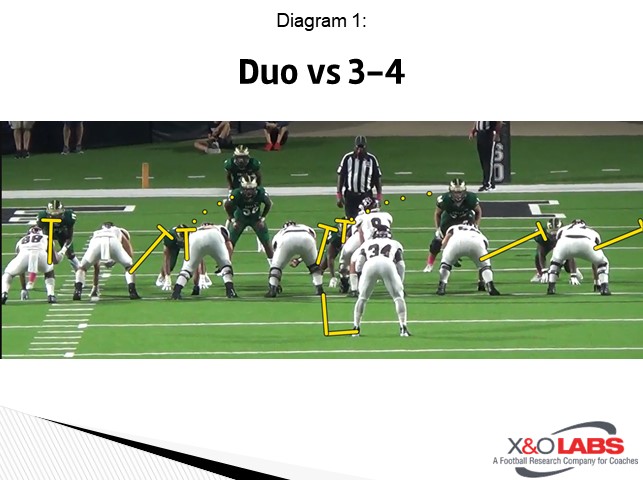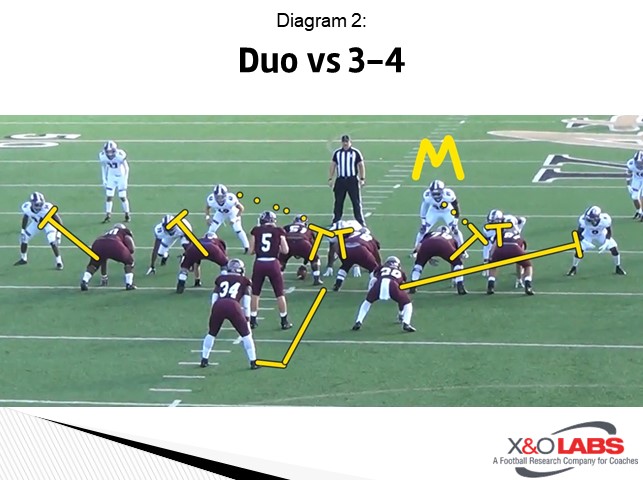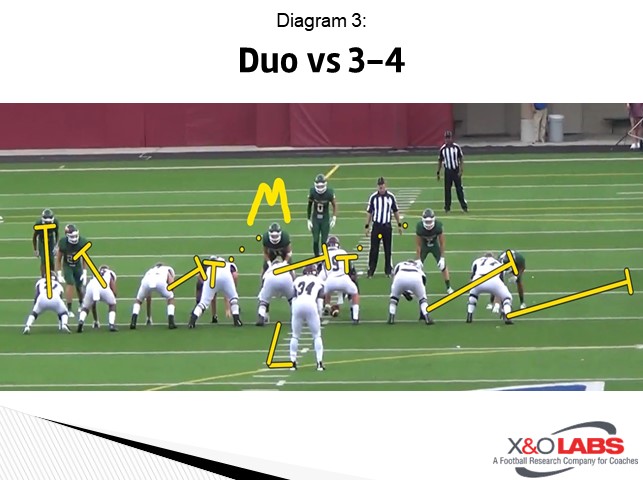By Michael Janak
Offensive Coordinator/Offensive Line Coach
Cy-Fair High School (TX)
At first glance, many people mistake Duo for Inside Zone. There are no pullers, it is a downhill run, and the running back seems to simply take his time waiting for a cut to open up. However, upon further study, you realize that it is something different altogether. Duo has much more of an emphasis on the vertical push at the line of scrimmage. The scheme of the play allows you to accomplish this because it provides two double teams at the point of attack. The offensive line can focus on establishing push because they are not chasing linebackers, the running back is reading the linebacker (Mike backer) and determining his cut off that read. I feel that the title of the article really sums up what this play is: Power without a puller. It is a physical, downhill run with little chance of a result of a negative play. At times, it can be much more of a dynamic play than power simply because it gives the ball carrier more options in terms of which gap the play can hit in. We started running this play at the end of the 2015 season and we have seen it for big plays all across the line of scrimmage.
We like this play against the basic fronts that are listed in the article. 4-2-5, 4-3, and 3-4. When opponents start bringing in extra defensive linemen, lining up in a Bear front, or doing some unconventional things in the box I don’t really like the play as much because you can lose your double teams. I’d much rather run power or outside zone at that point.
In terms of where exactly it fits in our offense, it is our third most called run play. Number one is Power, number two is Outside Zone, and number three is Duo.
We really don’t see teams game plan to stop Duo against us as much as they do Power simply because it is our third most common run. However, one thing I have seen teams try to send the weakside LB through the backside A gap or B gap on a delay. If it is an odd front the backer will go through the weakside A gap, hoping the center gets buried off in the double team on the Nose. If it is a four-down front, teams will send the weakside backer through the weakside B gap on a delay, hoping the guard is buried off in the double team. We try to make our linemen aware of this and make sure that they are keeping their eyes where they need to be.
Coaching Points:
QB: It is especially important that the QB comes straight back without pushing the RB off his landmark. If the QB forces the RB off his track, it is exceedingly difficult for the back to be able to make some of the backside cuts that may be available. The RB has to attack in the inside leg of the play side guard.
RB: Now, when I say that the running back is reading the Mike backer, that is exactly what I mean. If the Mike scrapes over the top of the double by the tackle and tight end, then the running back knows that the play now needs to hit B gap strong to B gap weak. If the Mike backer plugs or fills the B gap, the RB knows that he needs to bounce strong or cutback weak, avoiding the B Gap.
The RB will take a slide step with his play side foot, get downhill on the second step while taking the handoff, and attack the inside leg of the play side guard. One of the biggest coaching points for the RB is patience. We line up the RB at 8-8 ½ yards deep in the backfield when we run Duo. The reason for this is twofold. One, it allows the RB longer to read the Mike backer since he is getting the ball deeper. Two, it allows the offensive line to stay on their double team blocks longer and vertically push the line of scrimmage. The RB must be patient, trust his read, and get downhill with square shoulders.
OL: An important coaching point on the double teams is the use of the “Gallop” or “High Leg” technique. We started using this technique in 2016 and it has undoubtedly improved our double teams. The outside man on the double team (versus an odd front the play side guard and the play side TE) will "Gallop" into the double team. During the use of this technique, the inside foot will move inside and up the field, gaining as much ground as possible while still maintaining a good, athletic base. Next, the outside foot will move in the same direction to reestablish the base and basically put the lineman in what I call a "coil" position, ready to explode into the defender. When the base is reestablished, the lineman will explode into the defender using the "flipper" technique with their inside arm, attempting to launch the defender, while staying hip-to-hip with their inside teammate. From there, the inside foot must stay in front of the outside foot so the lineman can stay square. Once the lineman feels his teammate leaves the double team, he will transition into a "drive" block or "fit and finish.” The easiest thing I can compare this too is fencing. If you have ever watched fencing, very often they attack with one foot constantly remaining in front of the other. This allows the lineman to stay square on the double team and climb to the second level with square shoulders as well.
Duo Concept vs 3-4 Spacing:

Versus the Odd, the two double teams occur with the tight end and right tackle doubling the defensive tackle to the Mike backer, who is the read against the odd front. The playside tackle is looking for a fill or scrape from the Mike. Should the Mike scrape over the top of the double team, the tackle will press into the defensive linemen with his outside arm and stay on the double team. Should the Mike backer fill into the B gap, the tackle will slip off with square shoulders and pick up the Mike. If the defensive tackle slants inside to the B gap, the offensive tackle will pick him up and the TE will climb to the Mike backer. The second double team occurs with playside guard and center doubling the Nose to the weakside linebacker or will. If the Nose slants weak, the center will pick him up and the guard will climb to the will backer. If the Nose works strong or is shaded strong, the guard will stay on the Nose and the center will climb to the backer. The backside guard and tackle will handle the defensive tackle and outside linebacker by fanning out. The two backside offensive linemen should be able to handle any games or movement by those two backside defenders. Now, there must be someone to account for the playside outside linebacker, and this can be handled in a variety of different ways. It can be done with a fullback from the eye or offset.

It can be done with an H-Back or second tight end in motion. It can also be accomplished by using a wing or hip player that is lined up 1 yard away and 1 yard back from the inline tight end. There are a variety of ways to get a blocker to that defender.

To study game film of this concept, click on the video below:
Offensive Coordinator/Offensive Line Coach
Cy-Fair High School (TX)
At first glance, many people mistake Duo for Inside Zone. There are no pullers, it is a downhill run, and the running back seems to simply take his time waiting for a cut to open up. However, upon further study, you realize that it is something different altogether. Duo has much more of an emphasis on the vertical push at the line of scrimmage. The scheme of the play allows you to accomplish this because it provides two double teams at the point of attack. The offensive line can focus on establishing push because they are not chasing linebackers, the running back is reading the linebacker (Mike backer) and determining his cut off that read. I feel that the title of the article really sums up what this play is: Power without a puller. It is a physical, downhill run with little chance of a result of a negative play. At times, it can be much more of a dynamic play than power simply because it gives the ball carrier more options in terms of which gap the play can hit in. We started running this play at the end of the 2015 season and we have seen it for big plays all across the line of scrimmage.
We like this play against the basic fronts that are listed in the article. 4-2-5, 4-3, and 3-4. When opponents start bringing in extra defensive linemen, lining up in a Bear front, or doing some unconventional things in the box I don’t really like the play as much because you can lose your double teams. I’d much rather run power or outside zone at that point.
In terms of where exactly it fits in our offense, it is our third most called run play. Number one is Power, number two is Outside Zone, and number three is Duo.
We really don’t see teams game plan to stop Duo against us as much as they do Power simply because it is our third most common run. However, one thing I have seen teams try to send the weakside LB through the backside A gap or B gap on a delay. If it is an odd front the backer will go through the weakside A gap, hoping the center gets buried off in the double team on the Nose. If it is a four-down front, teams will send the weakside backer through the weakside B gap on a delay, hoping the guard is buried off in the double team. We try to make our linemen aware of this and make sure that they are keeping their eyes where they need to be.
Coaching Points:
QB: It is especially important that the QB comes straight back without pushing the RB off his landmark. If the QB forces the RB off his track, it is exceedingly difficult for the back to be able to make some of the backside cuts that may be available. The RB has to attack in the inside leg of the play side guard.
RB: Now, when I say that the running back is reading the Mike backer, that is exactly what I mean. If the Mike scrapes over the top of the double by the tackle and tight end, then the running back knows that the play now needs to hit B gap strong to B gap weak. If the Mike backer plugs or fills the B gap, the RB knows that he needs to bounce strong or cutback weak, avoiding the B Gap.
The RB will take a slide step with his play side foot, get downhill on the second step while taking the handoff, and attack the inside leg of the play side guard. One of the biggest coaching points for the RB is patience. We line up the RB at 8-8 ½ yards deep in the backfield when we run Duo. The reason for this is twofold. One, it allows the RB longer to read the Mike backer since he is getting the ball deeper. Two, it allows the offensive line to stay on their double team blocks longer and vertically push the line of scrimmage. The RB must be patient, trust his read, and get downhill with square shoulders.
OL: An important coaching point on the double teams is the use of the “Gallop” or “High Leg” technique. We started using this technique in 2016 and it has undoubtedly improved our double teams. The outside man on the double team (versus an odd front the play side guard and the play side TE) will "Gallop" into the double team. During the use of this technique, the inside foot will move inside and up the field, gaining as much ground as possible while still maintaining a good, athletic base. Next, the outside foot will move in the same direction to reestablish the base and basically put the lineman in what I call a "coil" position, ready to explode into the defender. When the base is reestablished, the lineman will explode into the defender using the "flipper" technique with their inside arm, attempting to launch the defender, while staying hip-to-hip with their inside teammate. From there, the inside foot must stay in front of the outside foot so the lineman can stay square. Once the lineman feels his teammate leaves the double team, he will transition into a "drive" block or "fit and finish.” The easiest thing I can compare this too is fencing. If you have ever watched fencing, very often they attack with one foot constantly remaining in front of the other. This allows the lineman to stay square on the double team and climb to the second level with square shoulders as well.
Duo Concept vs 3-4 Spacing:

Versus the Odd, the two double teams occur with the tight end and right tackle doubling the defensive tackle to the Mike backer, who is the read against the odd front. The playside tackle is looking for a fill or scrape from the Mike. Should the Mike scrape over the top of the double team, the tackle will press into the defensive linemen with his outside arm and stay on the double team. Should the Mike backer fill into the B gap, the tackle will slip off with square shoulders and pick up the Mike. If the defensive tackle slants inside to the B gap, the offensive tackle will pick him up and the TE will climb to the Mike backer. The second double team occurs with playside guard and center doubling the Nose to the weakside linebacker or will. If the Nose slants weak, the center will pick him up and the guard will climb to the will backer. If the Nose works strong or is shaded strong, the guard will stay on the Nose and the center will climb to the backer. The backside guard and tackle will handle the defensive tackle and outside linebacker by fanning out. The two backside offensive linemen should be able to handle any games or movement by those two backside defenders. Now, there must be someone to account for the playside outside linebacker, and this can be handled in a variety of different ways. It can be done with a fullback from the eye or offset.

It can be done with an H-Back or second tight end in motion. It can also be accomplished by using a wing or hip player that is lined up 1 yard away and 1 yard back from the inline tight end. There are a variety of ways to get a blocker to that defender.

To study game film of this concept, click on the video below:









